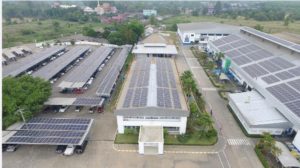As one of the first leading manufacturers for full bathroom solutions and kitchen fittings, GROHE has now achieved carbon-neutral production. GROHE has thus reached a central
milestone in its long-term commitment to sustainability.
“The initiative ties in seamlessly with the numerous measures in our plants that promote
the reduction of the carbon footprint and conserve resources. We are very proud to be a
pioneer in our industry with GROHE goes ZERO,” says Thomas Fuhr, COO Fittings LIXIL
International and CEO of Grohe AG. “And we are directly aiming for the next step: by the
end of 2021 we want to make all our sales offices worldwide climate-neutral.”
The initiative thus also contributes to a central goal of LIXIL’s sustainability strategy, of
which GROHE has been a part since 2014: by 2050, achieve net-zero carbon emissions from housing and lifestyle solutions as well as operations.
In order to achieve the self-imposed goal of carbon-neutral production, GROHE has been
using green electricity since July 2019 at all five LIXIL EMENA production sites, which
produce exclusively for the global brand, and in the German logistics centers. In addition,
the brand is investing in solar technology, combined heat and power plants and innovative
manufacturing processes such as 3D metal-printing that save materials to ensure a value
chain that conserves resources. Also the modern test laboratory in Hemer and an increased
recycling of materials contribute to the steady reduction of the carbon footprint. As a result, GROHE has been able to reduce its greenhouse gas emissions by around 40 percent
since the introduction of its 2014 sustainability program, while at the same time increasing its energy efficiency by 24 percent. As a result, the original targets of 20 percent each by 2021 have been significantly exceeded ahead of schedule.
GROHE supports two compensation projects to offset CO2 emissions that could not be reduced yet: the brand supports the operation of a hydroelectric power plant in India, which eliminates the need for coal-fired power plants, and a project in Malawi, which involves the repair and maintenance of boreholes used for drinking water abstraction.
As part of its carbon strategy, the sanitary brand intends to pursue the proven three-pronged approach of “avoid, reduce, compensate” and increase its energy efficiency every year by its own means, thereby reducing the share of compensation.
GROHE’s approach for a reduction of CO2 in consumers’ everyday lives
GROHE always strives to increase sustainability, not only with regard to its own production. The brand uses intelligent technologies to help consumers minimize their personal carbon footprint:
#1: Saving energy starts at the wash basin
Consciously selected products in the private bathroom not only save energy, but are also
easy on the wallet. Technologies such as GROHE SilkMove ES allow solely cold water to
flow from the faucet when positioned mid-lever. Unnecessary hot water consumption can
thus be prevented and, for a four-person household, save approx. 279kg CO2 and around
31,412 liters of water per year.
#2 Sustainable showering
For many, a refreshing shower in the morning is a great way to start the day. However,
people often wait unnecessarily long until they have found the right shower temperature –
valuable energy and water are lost in the process. Thermostats equipped with GROHE
TurboStat technology provide a more sustainable showering experience, delivering the
desired shower temperature within a fraction of a second and keeping it constant for the duration of the shower.
#3 Filtered drinking water straight from the kitchen tap
Bottled water is ubiquitous in everyday life, but it is certainly harmful to the environment.Up to 600g CO2 are emitted during the production and transport process of one litre of bottled mineral water.[1] The solution for more sustainability in drinking water: water systems such as GROHE Blue Home, a kitchen tap that supplies you with filtered and chilled water in still, medium or sparkling. A family of four can thus save up to 800 plastic bottles[2] each year and reduce their CO2 emissions by up to 61 percent[3].
[1] Carbon Footprint Studie der Georg-August-University Göttingen, Deutschland (2013)
[2] DHU 2019, www.duh.de/mehrweg-klimaschutz0/einweg-plastikflaschen
[3] Carbon Footprint Studie der Georg-August-University Göttingen, Deutschland (2013)


 التكنولوجيا وأخبارها بوابة مصر لأخبار تكنولوجيا المعلومات والإتصالات
التكنولوجيا وأخبارها بوابة مصر لأخبار تكنولوجيا المعلومات والإتصالات







